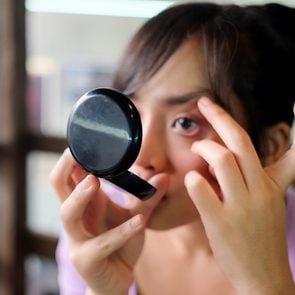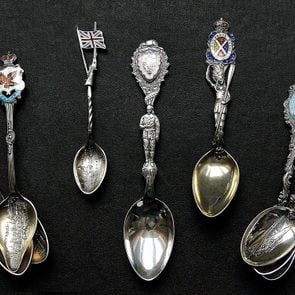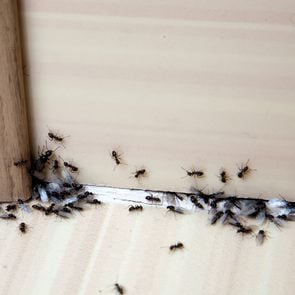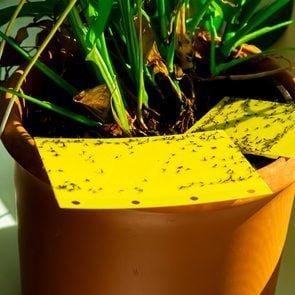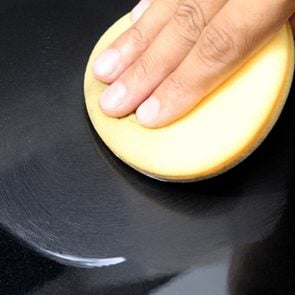
One of my favourite recreational and photographic destinations is not a plane ride away, a trip across an ocean or a cruise down a distant coast, but is merely a few kilometres drive from my home. St. Columba’s Cemetery in Pembroke, Ontario, is an old cemetery dating back more than 130 years that still remains in use—and it’s one of my regular weekly ports of call.
I began haunting graveyards when I first began to research my own family history. I was always intrigued by the names and carvings, as well as the variety in the styles of the tombstones, and the stories that they told about social history—to the eyes of the keen observer. Then I began to transcribe the inscriptions in area cemeteries—it was an excuse to return to some interesting places and an opportunity to make available to other researchers the kind of information that was useful to me when I began.
For years this particular cemetery in Pembroke held my interest as I conducted my genealogical research and found many ancestors and other relatives interred at this site. I was also part of the local genealogy group that recorded the tombstone inscriptions, even serving as the proofreader and editor of that publication. Later, it became an excellent resource when assisting others with their own family history research, and remains a source of local historical interest, as the tombstones and monuments are a rich resource about the people who settled in this area.
Having now retired from a teaching career that lasted more than three decades, I have found even more reasons to visit this local cemetery. It has become one of my favourite weekly walking locations as I am able to park the car and wander the several kilometres of criss-crossing roadways set in a grid pattern. Most of the lanes are paved, although some are still gravel. I can walk up a gentle rise, past the burial vault and back towards the forest border, weaving my way through the oldest section at the front and into the newer sections of more current burials, passing the recently installed columbaria in their own landscaped section.
Find out why Mount Pleasant Cemetery is one of Toronto’s hidden gems.

Walking through a cemetery is like taking a journey through time and looking back into the history of the area. Every monument and burial site has its own story to tell. I have always been fascinated by the seven-foot-tall cement tombstone handcrafted by a city labourer in 1927 (above), a charming monument in memory of his first wife. I pass the resting places of the priests of the diocese and two local orders of nuns, but always feel compelled to stop and read the names in a border section of the cemetery containing infant burials, once lying outside the original cemetery boundary and used for the interment of the unbaptized. And then there is the grave of a young hockey player, his jersey carved on the back of the tombstone, whose recent tragic death is remembered via trophies, mementoes and even a cup of Tim Horton’s coffee placed by friends and family visiting his grave.
My own ancestors are buried here as well and I always spare a glance and sometimes take a stroll off-road to visit the graves of several great- and great-great-grandparents. They are people that I never knew but through genealogical research and studying our family history, I feel close to them and enjoy the fact that I can spare a few moments to visit. After all, some parts of those people still live on in me, their descendant.
The walk is always quiet and peaceful—you would expect nothing else in a cemetery. Many of the trees are full grown and provide pockets of shade. They also attract all manner of birds, chipmunks, squirrels and insects and so the sounds of nature abound. Morning walks are cool and refreshing in the early sunshine while afternoon strolls can be balmy and lethargic. Evening walks are also tranquil as the shadows lengthen and stretch from the sun lowering behind the tall trees on the western border.

And while I am walking the lanes in this city of sleepers, I can indulge in yet another hobby—photography. I enjoy taking photos and, in my retirement, now have the leisure to pursue that interest as well. One of my favourite subjects can be found in most cemeteries, for I enjoy taking pictures of the statuary decorating the monuments, especially the angels. I’m not sure why I find angels so intriguing, but some of my best photographs are of the stone representations of those heavenly beings. In fact, I have a framed collection of angel photographs in a hallway of my home, and I recently created my own calendar with my pictures of angels. And this cemetery has some of my favourite angels, which I’ve now photographed from every angle, at every time of day and in every season.

I find myself spending time at least once a week in this cemetery. At this point some of you are probably asking, what in the world is he doing in a place like that? But those who have been there know that there is a peace like no other to be found in a cemetery; a calm, unhurried time that can be made especially pleasant by a warm summer morning or a sunny autumn afternoon. Some spots are scenic beyond description, perched on a hill top, framed by a green forest or beside the running waters of a creek.
In Victorian times, cemeteries were often used as parks where couples walked or families picnicked, a tradition we’ve grown away from in this modern age. Why not spend some time yourself at your own local cemetery? You might discover that you, too, are a tombstone tourist.
Check out more Canadian cemeteries worth exploring.

Stephen Chow knew something was off when he started making more typos and spelling errors in his work emails. This was in 2010, and Chow, 51 at the time and living in Scarborough, was an IT specialist for Ontario’s Ministry of Government and Consumer Services.
He tried to ignore the mistakes at first, but the situation became more obvious when attempts to punch in his password kept failing. He found it gradually harder to focus and perform simple, familiar tasks, such as calculating numbers or putting his signature on a document. “Everything was all messed up, and I didn’t know what to do about it,” he says. Not wanting his wife, Eva, and two adult sons to worry, he kept it a secret from them, hoping he could just muddle through.
Instead, over the next several years, more alarming symptoms appeared. As Chow made the daily 90-minute drive to and from work, he had trouble seeing the centre line on the road, as well as the cars beside him. In early 2014, his patchy vision almost killed him when he couldn’t clearly discern the road’s edge and slid into the ditch during a snowstorm. He was unharmed, but his anxiety mounted, and he decided to talk to his family doctor.
When Chow described his difficulties with typing and driving—both related to motor skills—his physician initially referred him to a specialist in Parkinson’s disease. That condition was ruled out because he didn’t have hand or leg tremors. In May of 2014, Chow got an appointment with Dr. Carmela Tartaglia, a cognitive neurologist specializing in early-onset dementia at Toronto Western Hospital.
Tartaglia suspected Chow’s symptoms were visual-spatial processing problems, a warning sign of Alzheimer’s disease—and she noted one subtle but telltale clue. “Stephen’s writing difficulties became more apparent in Cantonese,” she says. “It’s his first language, and Cantonese is a more visual language than English.”
Weeks later, an MRI showed a shrinkage of cortical tissue in the back of his brain—the region involved in processing what and how we see—and biomarkers identified in his cerebrospinal fluid 18 months later finally confirmed, six years after Chow first noticed his symptoms, that he had early-onset Alzheimer’s disease.
Why detection of early dementia symptoms is key
Chow is one of about 700,000 Canadians living with dementia. Although the rate of people who develop dementia has been declining for decades due to healthier lifestyles, the total number is still projected to double over the next 15 years because of the aging population. Each year, more than 75,000 Canadians are diagnosed with some form of dementia. Around 10 percent are under the age of 65.
Detection of early dementia symptoms is important so that the person diagnosed, and their family members, can take steps to slow and mitigate the effects of the disease through lifestyle changes. Ideally, that would mean seeing a family doctor, undergoing specialized testing and receiving a formal diagnosis within six months or a year after noticing symptoms. But according to an Australian study, on average, it took two years for people to make an initial visit to a doctor and over three years for a firm diagnosis.
People often associate dementia with memory loss, but in many cases this is not the first sign. In fact, dementia can affect many different areas of the brain, and scientists now understand that symptoms differ based on where in the brain changes occur. With this knowledge, doctors now use advanced tools, such as brain scans and protein biomarkers, to make earlier, more specific dementia diagnoses.
But getting to that stage requires noticing that something is wrong—and letting somebody know.
“The first time I knew Steve had a problem was when he called me from Dr. Tartaglia’s office,” says Eva. Once the diagnosis was made, she realized there had been indications. She just wasn’t aware of what to look for.
Here are 13 early dementia symptoms that suggest you should be assessed.

Your personality changes
Inappropriate behaviour is an early symptom of damage to the brain’s frontal lobes, which regulate our social judgment.
“People with this dysfunction might undress in public, talk about people’s private parts or say ‘That person is stupid,’” explains Dr. Robin Hsiung, neurologist and associate professor at the UBC Hospital Clinic for Alzheimer Disease and Related Disorders. “They lose social graces and forget that what they’re saying or doing isn’t right.”
These symptoms are often seen in frontotemporal dementia (FTD), but also when Alzheimer’s or vascular dementia affect the frontal lobes. If they’re not recognized, they can be particularly unsettling.
“The worst symptoms for families to deal with are when there is a personality shift and the person becomes increasingly agitated or even paranoid and suspicious,” says Carrie Bourassa, a professor at the University of Saskatchewan’s college of medicine who specializes in dementia and aging in Indigenous populations.
Unusual behaviour can sometimes be confused with psychiatric conditions, such as bipolar disorder or schizophrenia, and brain imaging can help rule out or support a diagnosis of dementia.
You see things that aren’t there
Recurring visual hallucinations may be an early symptom of Lewy body or Parkinson’s disease dementia, although people with Alzheimer’s disease can experience them, too. These can be as simple as seeing flashing lights or as elaborate as encountering animals and people that aren’t real.
“Sometimes the hallucinations are quite frightening, like seeing a wolf or a bear trying to break through the window,” says Hsiung. “Other times they’re more positive, like a grandmother who looks out the window and sees her grandchildren playing in the playground, but no one is there.”
Researchers believe that visual hallucinations may be caused by damage to the brain’s visual-processing system, in combination with the disease’s disruption of the sleep cycle—so that the visions might actually be dreams breaking into waking consciousness.
You struggle with vocabulary
Word-finding difficulties are among the most common early dementia symptoms. You might have trouble finding the right words during conversations or when naming objects, sometimes substituting the wrong word. People affected in this way pause while speaking, use filler words and frequently rely on “it” or “they” instead of specific names for things. Researchers at the University of Wisconsin-Madison found that these word-finding problems increased significantly in the span of just two years for people developing dementia.
Language can, in fact, be affected before memory problems emerge. An Arizona State University study analyzed former U.S. President Ronald Reagan’s press conferences and found speech changes more than a decade before he was diagnosed with Alzheimer’s.
To assess whether your word-finding challenges are related to a shrinkage in the language areas of your brain, pay attention to when and how often this happens. It could simply be a result of being tired or stressed—and can be caused by anxiety, depression, stroke and delirium, as well.

Your vision is patchy
Problems with spatial awareness can be caused by cataracts or glaucoma, but they’re also one of the early dementia symptoms. This was the case with Chow, whose first Alzheimer’s symptoms were caused by a shrinkage of the area of the brain crucial to his ability to accurately perceive the world three-dimensionally.
“A patient with posterior cortical atrophy may see the world in a patchy visual field,” explains Hsiung. “If the person is focusing in front while driving, he can’t see things off to the side. And if he’s changing lanes, he can’t see other cars beside him.” Meanwhile, when Chow made mistakes typing, he was having trouble seeing the whole keyboard.
Tartaglia notes that visual-spatial processing problems are especially prevalent as an early sign of Lewy body dementia, which can affect a similar area of the brain.
You find it difficult to keep focused
In addition to visual-spatial processing issues, Chow also had trouble with concentration due to shrinkage in his frontal lobe. “That made writing, reading and driving difficult and affected his ability to do high-level tasks as an IT specialist,” says Tartaglia.
Beyond Alzheimer’s, any other kind of dementia can affect this area of the brain—but note that an inability to focus can also be caused by anxiety, depression and side effects to medication.
You forget where you’ve put things
It’s not unusual to occasionally forget where you stashed your keys. But if you find that you’re doing this regularly, leaving the stove burner on or frequently forgetting recent events and conversations, this could be a warning sign. Commonly, says Hsiung, people with this type of memory loss will ask loved ones the same questions over and over again.
“Families can help a lot in recognizing these early symptoms, because if the person’s memory is poor, they won’t remember the problems they have in remembering,” he says.
This sign is one that often points to Alzheimer’s disease. In this type of dementia, the hippocampus—the brain area involved in forming, storing and retrieving memories—may be affected first. In fact, short-term memory loss is the most common symptom among people with Alzheimer’s disease, whereas it’s less often an early sign in vascular dementia and Lewy body dementia, and rarely in FTD.
Medications and depression can also affect memory, so it’s important to check with your doctor, who might recommend a screening test, such as the Montreal Cognitive Assessment—30 questions which quickly identify abnormal brain function.
You’re suddenly bad with money
A pattern of uncharacteristically poor financial decisions should set off alarm bells. “When you have frontal-lobe damage, you lose judgment and can make rash, impulsive financial decisions,” says Tartaglia. “A frugal person starts giving away more money or buying things they don’t need—like a furnace from a door-to-door salesperson.” She’s seen patients who did significant damage to their families’ finances, as well as CEOs of companies who lost millions because nobody noticed the signs.
A combination of declining decision-making skills and memory can also lead to financial lapses. A JAMA Internal Medicine study from 2020 found that people with dementia started missing bill payments up to six years before they were diagnosed.
You’re emotionally flat
According to a University of Cambridge study, a lack of interest or motivation can predict the onset of dementia many years before other cognitive symptoms do, especially in people with FTD, who may be diagnosed as early as age 45.
Hsiung cautions, however, that apathy can sometimes be confused with depression, as the difference between them is subtle; a psychiatric assessment is often required to tell them apart.
“In both, a person may sit on the sofa all day long,” he says, explaining that the key difference is how much their mood ranges. If someone becomes tearful when they hear a sad story, this could be depression, but it’s apathy if the person shows no emotional response. If it’s the latter, Hsiung says, it could be the beginning of Alzheimer’s disease, FTD or vascular dementia.
You’re not moving as well as usual
Difficulties with movement and performing physical activities in the right sequence can be an early sign of damage to the parietal lobe, which is related to motor skills—and this is one of the signs that Eva thinks she overlooked in her husband. Three years before his diagnosis, the couple began to participate in dragon-boat racing. Chow had always been a well-coordinated athlete and handyman, but during training he struggled to learn the basic stroke technique. “The coach kept telling him, ‘This is the way you do it.’ Steve didn’t get it very well, and he was upset with the coach,” says Eva.
Motor problems are also common with Lewy body dementia, but other neurodegenerative conditions, such as Parkinson’s and multiple sclerosis, should be considered, as well.
You’ve become insensitive
According to a 2016 Neuroscience Research Australia report, loss of empathy is a core symptom in some people diagnosed with FTD. It’s related to loss of grey matter in the social brain. These patients are unaware of the impact of their behaviour on others, and they lose both the ability to understand other people’s emotions and to share in their feelings.
“You may not care about your family anymore,” says Tartaglia. “Or a family member is crying, but you don’t recognize they are sad.”
You no longer grasp concepts you once did
Problems with tasks that require abstract thinking, such as understanding numbers or reading a house plan—especially if that was a strength before—are early dementia symptoms that can be caused by damage in the frontal and parietal lobes. For Chow, this appeared early at work in his inability to make simple calculations, but it also impeded his long-held role as the manager of his family’s finances. After his diagnosis, Eva took over those duties.
You’re more anxious
Mood changes, such as depression and anxiety, can be early dementia symptoms that start well before people begin to experience memory loss, according to a 2015 Neurology study. Tartaglia notes that, especially with Lewy body dementia, non-anxious people can become anxious much of the time. They may exhibit persistent worry, fear or agitation, commonly triggered by going outside the home or being separated from a family member.
You get lost more often
Losing navigational skills, and the ability to create a mental map of your environment, can be one of the early dementia symptoms. In fact, in 2019, University of Cambridge researchers developed a virtual-reality navigation test that has proven to be better at identifying early Alzheimer’s disease than FDA-approved neuropsychological tests currently considered to be a gold standard for early diagnosis.
“We built a running track in our backyard so Steve could jog safely every day without getting lost,” says Eva.
Once Chow was properly diagnosed, his anxiety about his symptoms decreased and he became calmer. “Eva is the model caregiver because she wants to do what’s best for Stephen and encourages him to do things,” says Tartaglia. This has included joining Alzheimer Society of Toronto programs and support groups for people with early-onset dementia, practising daily meditation and getting regular aerobic exercise.
But perhaps most importantly, with Eva’s encouragement, Chow began to share his dementia diagnosis with the people in his life. “I felt better after I told my family and friends,” he says. “They were very supportive, and it took a load off my shoulders. I learned that you should tell people what you’re noticing sooner rather than later and not keep it to yourself.”
Types of dementia
Rather than one specific disease, dementia describes a group of symptoms that are caused by disorders affecting the brain. There are more than a dozen types of dementia, including rare conditions and others that may develop from other brain disorders, like Parkinson’s disease or Huntington’s disease.
Here are the five most diagnosed forms of dementia:
Alzheimer’s disease is the most common type of dementia, accounting for up to 80 percent of all diagnoses. Generally, Alzheimer’s affects most areas of the brain as it progresses and can therefore involve changes in memory, language, problem solving, mood and behaviour.
Vascular dementia, the second-most-common type, happens when there is a blockage to the brain’s blood supply, which causes brain cells to be deprived of oxygen and die. Strokes, transient ischemic attacks and blood-vessel disease are common causes of vascular dementia and can affect different brain areas.
Lewy body dementia is caused by abnormal deposits of a protein called alpha-synuclein inside the brain’s nerve cells. This protein, which destroys brain cells, is also found in people with Parkinson’s disease. Areas of the brain involved in thinking, movement and visual processing are most affected.
Frontotemporal dementia mainly affects the frontal and temporal brain areas and accounts for about 20 percent of cases of early-onset dementia. Changes in personality and behaviour are more apparent in the early stage, while memory decline often doesn’t occur until later.
Mixed dementia occurs when a person has at least two different types of dementia, most often Alzheimer’s disease and vascular dementia. Studies reveal it’s much more common than previously thought.
Now that you know how to spot the early dementia symptoms, find out how this MIND diet meal plan feeds your brain.

My husband’s cousin, Hélène, my friends Colette and Danielle, and I are part of a devoted and enthusiastic group of people who collect aprons, dolls, figurines, glasses, umbrellas and other collectibles associated with “Bécassine,” a popular French comic strip from the 1900s. The series, featuring a housemaid from the early 20th century, was first published in the magazine La Semaine de Suzette in 1905. It found huge success among young girls at the time. To this day, Bécassine continues to be popular, and many collectibles are still available on the market. The comic strip has also inspired numerous Canadian artists, including stained-glass artist Michel Bélisle.
Every time one of us goes to France, we, as amateur collectors, come back with coasters, some delicious galettes bretonnes (cookies) packed in a Bécassine tin box and any other memorabilia we can find.
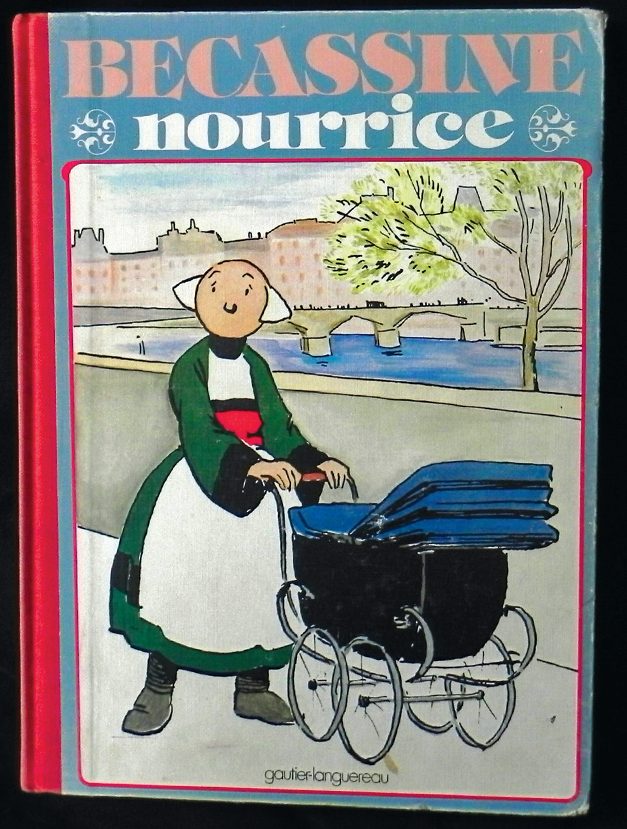
The Origins of Bécassine
The long-time writer of the strip was a woman named Jacqueline Rivière, and the artist who illustrated the series was Émile J.P. Pinchon. Maurice Languereau, known under his pen name “Caumery,” later began to write the stories, while Pinchon continued to illustrate Bécassine’s adventures until 1953.
My friend, Colette, first read the comic strip in a magazine her mother had bought, while my first time picking up a Bécassine was at our public library. The use of pastel colours, the funny sketches, the vintage nanny—it all looked quite unusual to me.
The selling point for me was that her stories took place in France. The comic strip depicted Brittany architecture, traditional folk costumes for both men and women, and used bizarre French terminology and phrases, especially when Bécassine opened her mouth or wrote a letter. In fact, Colette wondered how Bécassine could make so many mistakes in every single sentence.
The comic strip writers named the beloved French-born character Annaïk Labornez. In her fictional universe, there were many babies bearing the same first name, which is why she was given her iconic nickname, Bécassine. The nickname, which in English translates to “snipe,” a small bird species with a long beak, was given to her by Uncle Corentin, her godfather in the comic strip. Uncle Corentin was a very good man, and always helped Bécassine when she got herself in trouble, which happened quite often throughout the series.
Her parents were peasants and worked hard on their pig farm. Bécassine had a favourite pig, named Polycarpe, that was not like the others because of its funny-shaped tail. When she turned six, Bécassine attended the local school. The character was never the brightest in her class, but she always worked hard. She grew up as a peculiar Bretonne girl, full of imagination, constantly asking questions and always had 101 awesome ideas in her head. She later became a protégé for Madame la marquise de Grand-Air, who was a woman of French nobility, and who lived in her castle not too far from Bécassine’s family farm. Bécassine eventually became a housemaid and nanny for Loulotte, the marquise’s granddaughter.

Glimpses of Brittany
Early in his career, artist E.J.P. Pinchon wasn’t earning enough money selling his paintings, and so he started drawing sketches for magazines. When he began illustrating the Bécassine books, readers got glimpses of Brittany in the illustrator’s iconic realistic style. With Pinchon, readers were transported to the northern part of France where the maritime landscape is absolutely astonishing. The first volume that attracted my friend Danielle was a book that her mother had received from her own mother. Danielle asked for more of them for her birthday, which marked the beginning of her love for this fearless Bretonne. In 1931, the publisher launched “Bécassine fait du scoutisme.” Danielle, being a Girl Guide herself, fell totally in love with this particular edition.
Nowadays, even young girls like Zoé, Colette’s granddaughter, are reading and hearing stories about this beloved fictional nanny. My husband’s cousin Hélène even named her cat Bécassine. The cat, who would live for over 21 years, helped Hélène’s kids to learn how to walk, as they would slowly follow the feline’s tail.
We all continue looking for items depicting “la petite Bretonne” in her traditional getup. But one thing is for sure, Bécassine will forever make us smile.
Next, check out these quirky Canadian museums.
Have you ever taken a close look at your tires? If so, you’ve likely seen a series of numbers and letters imprinted in the rubber. What exactly do those numbers mean, though? And why are they there in the first place? Well, turns out, those numbers are more than just a weird car feature—in fact, they serve an important purpose. Here’s why tires have numbers on them and what they actually mean.
What do those numbers on tires mean?
Each number and letter on your tires mean different things. Let’s take this example tire code and break down what each part means: P235/75R15 105S
- P—The P in the beginning of this number stands for the type of tire you have. “P” means the tire is made for lighter passenger cars. If you see “LT” on your tires, it means they’re made for heavier vehicles like SUVs and light trucks.
- 235—This number indicates the width of the tire, measured in millimetres. The width is measured from sidewall to sidewall, a.k.a. the smooth vertical section on your tire’s side.
- 75—This is the tire’s aspect ratio, comparing the tire’s height to its width. For this tire, it means its height is 75 percent of its width.
- R—This defines the construction within the tire. “R” stands for radial. “B” means belted bias and “D” stands for diagonal bias construction.
- 15—This is the wheel’s diameter, commonly measured in inches.
- 105—This is the tire’s load index, a.k.a. how much weight the tire can support. A tire with a 105 load index can support a maximum weight of 2,039 pounds (925 kilograms).
- S—This is the tire’s speed rating. This is the maximum speed your car can reach before the tire’s rubber risks being damaged, and each letter represents a different speed. “S” is 112 miles per hour (180 kilometres per hour). Just because your tire can function up to this speed, though, does not mean you should speed on the road.
Why do those numbers on tires matter?
The numbers on tires matter for several reasons. For starters, it tells you the size of the tire, which is important to know. Putting the wrong sized tires on your car can lead to a number of hazards, such as rubbing against the body of your vehicle and catching important electrical lines. Driving on the wrong sized tires over time can also cause long-term tire wear, which can impact your car’s overall function.
If you aren’t sure what size your tires should be, visit a tire expert. They’ll help you find the right sized tires and provide advice on how to keep them in good shape.
Next, find out why car windows have those little black dots.

As a registered dietitian, one of my favourite jobs is to fine-tune recipes to create options that are both delicious and healthful. My Banana Dark Chocolate Mini Muffins accomplishes both; and they’re fun and easy to make.
A number of my tweaks significantly up the nutritional value of this recipe, but bananas are the star. One medium banana provides 12 percent of the daily need for both fibre, which supports good digestive health, as well as potassium, which behaves as an electrolyte and supports heart rhythm, nerve and muscle function. It also helps regulate blood pressure. Bananas also supply vitamin C for immune health, energy supporting B vitamins and manganese, a mineral needed for healthy bones, wound healing and collagen production. They also pack healthy antioxidants, which can help protect against heart disease and cancer.
Mmm, chocolate
The fruit’s chief co-star in this recipe is dark chocolate. In addition to being decadent, dark chocolate deserves its superfood status. Some research suggests it may help protect the heart and reduce stress and inflammation, while improving memory, immunity and mood and even support bone density. To further boost the healthiness, I opted for antioxidant-rich maple syrup in place of refined sugar, protein, and nutrient-rich chickpea and almond flours rather than white flour, and heart-healthy extra virgin olive oil (EVOO) instead of butter. The combo of banana, maple syrup and EVOO give the muffins their moist texture. These gluten-free, 100 percent plant-based goodies are just as flavourful and satisfying as a traditional version, and the cinnamon aroma is intoxicating.
Divide and conquer
Rather than making four larger muffins, I opted for 12 minis, with one serving being three petite muffins. Research shows that your brain perceives a greater number of items as a larger quantity, even if the total portion is identical. This perception translates into feeling more satisfied with three minis rather than one larger muffin. If you don’t have a mini-muffin pan, you can divide the batter into four larger muffins, but here’s a trick: Cut your muffin into smaller pieces before you eat it, so you’ll feel like you’re eating more.
To further boost the plant protein content in my meal, I like to serve my minis with a latte made with a higher protein plant milk. Another fun option is a parfait made with layers of three quartered mini muffins alternated with plant-based yogurt.
If you prefer a savoury breakfast, enjoy these muffins as an afternoon snack or dessert. Just popping one can satisfy a sweet craving while delivering some key nutrients. Here’s the recipe. I hope you enjoy it as much as I do!

Banana Dark Chocolate Mini Muffins Recipe
Serves four
Ingredients:
- ¼ cup chickpea flour
- ¼ cup almond flour
- 1-½ teaspoons ground cinnamon
- ¼ teaspoon baking soda
- ¼ teaspoon baking powder
- 1/8 teaspoon sea salt
- ¼ cup mild-flavoured extra virgin olive oil
- ¼ cup pure maple syrup
- 1-½ teaspoons pure vanilla extract
- 1 cup banana slices, divided
- ¼ cup chopped 70 per cent dark chocolate
Instructions:
Preheat oven to 350 F. In a large bowl, combine chickpea and almond flours, cinnamon, baking soda, baking powder and sea salt, and set aside. In a mini food processor combine oil, maple syrup, vanilla and half of the banana. Blend until smooth, and then fold the wet mixture into the dry ingredients and stir to mix the batter. Mince the remaining banana slices and stir into the batter along with the chopped dark chocolate. Evenly spoon the batter into 12 paper cup lined mini muffin cups. Bake for 15 minutes or until toothpick inserted into centre of muffin comes out clean.
Next, find out 12 high-fibre foods worth adding to your cart.
The email popped up on my screen at 6:45 a.m. on December 24 last year. I’d already been up for a couple of hours, working to deadline. It was from someone I know quite well: the minister of West Vancouver’s North Shore Unitarian Church, which my family attends.
“I need a favour from you,” the message said. “Email me as soon as you get my message.”
“Ahoy Ron,” I replied.
A friend was in the hospital battling cancer, he said, and he’d just learned she was scheduled for surgery that night. Could I possibly pick up some iTunes gift cards? “She needs the cards to download her favourite music and videos to boost her confidence on her next phase of surgery.” He’d do it himself, but he was tied up, he explained. “I will surely reimburse you as soon as I can.”
No one else in the house was up, so there was no one to run this by. But then, I probably wouldn’t have asked for a second opinion anyway. It didn’t really occur to me that this might be a scam.
“OK,” I emailed back.
“Thank you so much, Bruce,” my correspondent replied. Then he got down to business. I was to buy $300 of iTunes credit. (That is quite a lot of music, I thought.) “I need you to scratch the silver lining at the back of each card to reveal the redemption code, then take a snapshot and send them directly to Sharon’s email.” He gave the address.
“Let me know when you’ve sent it,” he wrote. “God bless.”
God bless? We’re Unitarians. Optimistic agnostics at best. The “G” word doesn’t come up much. Totally weird sign-off there. I assumed Ron’s mind was still on the dire circumstances of his friend Sharon, who was evidently a Christian.
“I can pick up the card around noon and engineer this by tonight,” I replied.
He was super grateful, he replied six minutes later, but that would be too late. “Can you please send them to her by noon so she could be able to use them before her surgery?”
This was awkward timing. But hey, what was my slight inconvenience against this woman’s cancer fight—on Christmas Eve, no less? I drove to the grocery store and purchased four gift cards. The clerk activated them at the till. At 9:30, I emailed pictures with the following message:
Dear Sharon,
The codes on the cards below will buy you music via iTunes.
Everybody is pulling for you.
They tried to double-dip on this dupe
A busy Christmas Eve day then unfolded. I forgot all about this until, around 4:30 p.m., while waiting for takeout fish and chips, I checked my email. A follow-up message—one that contained some odd grammar—was sitting in my inbox.
“Sharon just emailed me now saying she got the cards. I want to really appreciate you for that. I’m sure it’s going to go a long way in her fight over cancer.”
But now there was a new development. Apparently, word of the gift cards had made its way around the cancer ward. Other patients were asking Ron for the same thing.
“Could you please get me additional $500 worth of iTunes gift cards right away? I will be paying you back $800. I’m so sorry for the inconvenience.”
This was a bridge too far. The personal friend was one thing, but random strangers on the ward?
I called Ron.
“Hey Bruce. What’s up?”
“Are we too late to help those other patients?” I asked.
Silence. Then: “Um, I don’t know what you’re talking about.”
“Those other patients on the ward who now also want music,” I said.
“Bruce.” A long beat. “It’s a scam. Somebody has been impersonating me. I put out a warning on Facebook.”
“I didn’t . . . see that.”
Why we let ourselves fall
Phishing, “the easiest and the most productive attack vector used by criminals,” as one security consultant put it, is now so common it’s practically a demonstration sport at the fraudster Olympics. Indeed, reports of this exact scam I’ve just described can be found on the Internet in five seconds. But it never occurred to me to check. The question is, Why?
Near the end of the film The Sixth Sense, director M. Night Shyamalan springs his trap. And you go: Wait. Bruce Willis is . . . dead? I remember feeling stung. Disoriented. And yet, in retrospect, the evidence was there all along.
It was exactly the same experience when Ron—the real Ron, that is—said over the phone: “It’s a scam.” There was the sudden reframe, the forehead-smacking denouement.
That is the brain on a well-crafted fiction, says Vera Tobin, a cognitive scientist at Case Western Reserve University in Ohio and the author of Elements of Surprise: Our Mental Limits and the Satisfactions of Plot. The sympathies and attention of the “victim” are expertly manipulated by narrative sleight of hand.
The stakes start small. In my case, the initial contact was modest and believable. There were the shoe-shuffling apologies, the thanks in advance. From there, the story unfolded. Next thing I knew, I was putting on my jacket.
Scammers exploit thinking errors in the same way storytellers do. We are “cognitive misers,” says University of Toronto psychologist Keith Stanovich, taking mental shortcuts and jumping to conclusions wherever possible. That’s why Stanovich insists that gullibility isn’t a sign of low intelligence. It’s a sign of “low rationality,” which is different. The front brain never has a chance; the horse has already left the barn with that first snap judgment.
Scammers take advantage of other cognitive errors, too, like “optimism bias.” Most people think they’re a little bit charmed, a little luckier than average. We harbour a personal fable that things are likely to go well for us. The possibility that we’ve been hoodwinked just isn’t as “available” as a happy ending.
And then there’s “consistency bias,” which says people tend to act in accordance with whom they believe themselves to be. When I received the first email it spoke to my sense that I’m a nice guy, and here’s an opportunity to prove it. “You were on a goodwill mission,” said the cop at a North Shore RCMP detachment who dutifully took down my report. “And that kind of put blinders on you.”
Lastly, behavioural economists coined a term, “anchoring,” which psychologists also use—the act of relying too heavily on one piece of information. “It’s hard for people to set aside something they already know,” says Tobin. “And that, then, constrains our ability to reason.” The scammer had fixed in my mind the image of a cancer ward, and to make matters worse, I could see Sharon in my mind because I have been there—I was at my father’s bedside when he died of cancer.
All these factors together may incline scam victims to overlook what should be glaring red flags. My minister didn’t use my name in the first email. Then again, maybe he was in a hurry? (The scammer didn’t use my name because he didn’t have it. Until, with my response, I gave it to him.) And the grammatical errors from a person I knew to be fastidious with language? I chalked it up to stress. Basically, I read those emails through a filter that cleaned up the language and imputed only good motives.
Profile of a likely scam victim
If successful scams exploit these universal cognitive biases, why don’t all of us fall for them? Around 20 percent of the population is especially vulnerable to scams, says Stephen Lea, a psychologist at the University of Exeter. And of the folks who receive phishing emails like mine, only around three percent actually bite, according to a recent study by telecom giant Verizon. So we few, we sorry few, we band of schlemiels: What’s different about us?
There’s a widespread perception that scam victims are predominantly older folk. But that isn’t quite right. Millennials are actually scammed more than any other group, according to Federal Trade Commission data from the United States. But they lose less money than seniors because they have less. (Curiously, seniors are more likely to get scammed face-to-face. One theory is that older people are less likely to notice visual cues of insincerity.)
The stereotype that the lonely are sitting ducks is true. Lonely people are more likely to let scammers get their foot in the door; they open unsolicited mail and stay on the line with those bogus Canada Revenue Agency officers.
I’m not lonely nor a millennial. But I was randomly phished in a pool that is viewed as promising for scammers: a minister’s congregation. There’s evidence that con artists disproportionately target religious groups—although it’s less clear whether “people of faith” are actually more gullible to such scams. Most Unitarians, I’d venture, are of the “trust but verify” variety. And sure enough, I learned that no one else in my congregation was fooled. This scammer was lucky to have found me.
“Remember the time you almost bought a car with a lien on it?” my wife reminded. “Or the time you went to the Downtown Eastside to pay the guy who said he’d found your stolen camera his promised finder’s fee?” (He collected the fee up front, then disappeared into his apartment to “get the camera,” never to be seen again.) She started enumerating the scams she could remember; it took two hands.
Perhaps gullibility, as Stanford psychiatrist David Spiegel believes, is a “neural trait” in the way that hypnotizability is. (Brain scans of “very hypnotizable” people reveal distinct activity patterns, Spiegel found.) Whether that proves true, there are other character traits that we scam victims demonstrably share.
We are decisive. Okay, impulsive. Deficient “depth of processing” is another way to put it, and mine was abysmal in this case.
“Naive” or “trusting” could also apply, although social scientists prefer the descriptor “unsuspicious.” And we are “risk takers,” physically, financially and emotionally. Psychologist Stephen Lea found that self-reported risk takers were much more likely to be victims of scams.
You’d think ignorance would be a precondition of getting bilked. But weirdly, the opposite may be true. Sometimes the problem isn’t knowing too little but too much. One of Bernie Madoff’s victims was a psychiatrist named Stephen Greenspan, who lost about a third of his retirement savings to Madoff’s Ponzi scheme. Just two days before he learned he’d been hoodwinked, Greenspan had published a big authoritative tome, the fruit of decades of research in his area of expertise. It’s called The Annals of Gullibility: Why We Get Duped and How to Avoid It.
Overconfidence, it turns out, can produce a kind of unwarranted swagger, an almost comically obtuse misreading of events. The more we know, the less likely we are to second-guess our initial take on something.
I had actually been in the middle of editing some articles on how to avoid scams when the first email arrived. This should have made me be able to smell a ruse at 50 paces. But here’s the thing: while I had a solid general knowledge, I’d never encountered this particular scam. There was no Nigerian prince, no one claiming to be from the Canada Revenue Agency or Microsoft or Apple. It didn’t even involve money directly. Why would a crook want music? (The answer is, of course, that they don’t. The reason scammers ask for iTunes gift cards is simple: the codes are hard to trace. And, once they have them, they can resell them.)
“I’m afraid there’s nothing we can do,” said the agent from Visa’s fraud department after silently hearing out my whole story, back on shift after Christmas break.
“Why not?”
“Because it’s not fraud,” he said. “When we dispute a charge, our claim is against the merchant. But the merchant didn’t do anything wrong here. You willingly purchased those gift certificates.”
Wait, what? I didn’t willingly purchase them. Or did I?
I was drawn to drama
What distinguishes fraud from all other crimes is that it demands cooperation from the victim, notes Lea. Or, in other words, the dupe is always complicit. But what could possibly be the payoff in getting robbed?
Maybe the answer is not so different from why we go to magic shows, or The Sixth Sense–style movies with whip-crack endings. It’s weirdly pleasurable to suspend our disbelief and then have the rug pulled out from under us. “That ‘aha’ moment,” says Tobin, “is something humans like a lot.” The tension and release, after being expertly led into jeopardy, is something I’ve probably been missing on the flat sea of midlife.
And of course, for a writer like myself, drama is its own kind of payoff. What did I get out of the whole ordeal? Well, I got a “moment”—a frisson of aliveness, a memory to distinguish this day from all others, forever. And, not least, a story.
Next, check out the latest scams Canadians are falling for.
Each fall, boxelder bugs and Asian lady beetles search for a warm winter shelter. Unfortunately, your house may be the place they pick.
While you may find these red and black bugs throughout the year, fall is when they really become pests. Here’s what you need to know about boxelder bugs and Asian lady beetles, as well as three other red and black bugs that could be lurking in your yard.

Boxelder Bugs
Many of the red and black bugs on this list look similar. You can distinguish between them by their distinctive behaviours and markings.
If you have a large congregation of ovular, red and black bugs on the sunny side of your house each fall, your problem is probably boxelder bugs (above). They’re infamous for covering outer walls in search of the last rays of summer sun. Can you blame them?
You can get rid of boxelder bugs outside by applying pesticide and covering potential entryways. If they do make their way inside, know that they do not cause structural damage or breed within your home, unlike termites. Once they are inside the house, simply vacuum them up with a hose attachment. They may leave behind stains if you crush them.

Asian Lady Beetle
Asian lady beetles are often called ladybugs because the two insects look nearly identical at first glance. If you have small, round, black and orange beetles in your windowsills, the Asian lady beetle is the most likely culprit.
Like boxelder bugs, you may find these unwelcome pests in high numbers, but they don’t typically cover sides of buildings in quite the same way. Instead, they’ll weasel their way into your home to escape the oncoming winter, buzz around your light bulbs for a while, then drop dead before spring. They are a predator to the native ladybug. And although mostly harmless, sometimes they bite.

Native Ladybug
Native ladybugs are less common than the invasive Asian lady beetle these days, but they are more desirable to gardeners. Unlike the Asian lady beetle, ladybugs do not bite or invade homes in the winter. Plus, their appetite for aphids and other plant-eating insects makes them a great natural pest control. (Here are more gardening tips you’ll wish you’d known sooner.)
To distinguish between these two red and black bugs, look at their size and markings. There are many species of true ladybugs, but they are usually smaller and rounder, with little white spots on their cheeks. Asian lady beetles have more white markings in general, including larger cheeks and an M shape where the head meets the body.

Scarlet Lily Leaf Beetle
Another red and black bug that could wreak havoc in your garden is the scarlet lily leaf beetle. These are particularly annoying for those who are fond of lilies. These beetles are red on top and black on the bottom.
According to Gardener’s Supply Company, the adult beetles munch on lily leaves and lay eggs on their undersides. Their larvae can decimate leaves, buds and flowers.
Scarlet lily leaf beetles overwinter in the ground, so you don’t have to worry about them invading your home in the fall. These pests are worst in the spring—around the time daffodils and lilies bloom.

Milkweed Bugs
Common milkweed is one of the best flowers for bees, butterflies and other pollinators. (Find out more things you can do to save the bees.) It blooms with round clumps of small, mauve, good-smelling flowers. Most people plant milkweed to attract monarch butterflies. However, it can attract nuisance bugs as well.
If you have this plant in your yard, keep an eye out for the boxelder bug-like group of black and orange beetles known as milkweed bugs. The Save Our Monarchs Foundation gives an overview of four milkweed bugs. Only one species, the small milkweed bug (pictured), is harmful to monarchs. Look for an X or hourglass shape on its back to distinguish the small milkweed bug from other red and black bugs.
Now that you can identify these red and black bugs, find out the 10 most disgusting house bugs—and how to get rid of them.
As a nature photographer, it is the best time of year to get out and photograph the beautiful colours that nature has blessed us with. I am lucky to live in a place that is so abundant with trees that produce leaves of bright reds, oranges and yellows. Among the first leaves to change are those of red maple trees. This begins in September, and the spectacular progression of changing colours continues right through October.

I wait until the leaves are ready to peak to their fullest colour, then I plan my route around the area, starting with a drive along Quebec’s Gatineau Parkway.
I head out early in the morning, trying to beat the crowds, as it gets rather busy by the afternoon. I start my day trip from Chelsea, Quebec, which is the gateway to Gatineau Park. From there I can drive the complete loop that accesses all the spots I want to visit.

A Gatineau Park Fall Photography Tour
The first stop on my tour is Pink Lake, one of the most popular sites in the park, which means that the parking lot fills up quickly. But I patiently wait for someone to leave; it doesn’t take too long, as there are many more areas to visit. The wait pays off, as I capture some beautiful images. A meromictic lake, which means that the water at the bottom doesn’t mix with the water at the top, Pink Lake is one of the park’s most unique features. In the fall, it is surrounded by vibrant colours that make it a must-stop for photographers like me. The lake has a trail that allows you to walk around its edge, and there are platforms situated at various spots for you to capture that perfect image of the entire lake, with its cliffs covered in colourful foliage.

My next stop is Mulvihill Lake, which is named after my ancestors, and Black Lake, which lies at the base of King Mountain. These lakes are smaller but still offer the opportunity to photograph gorgeous views of the colourful trees that surround them. Every year, these trees seem to produce lots of bright-red and orange leaves, which is why I always make sure to include them on my Gatineau Park fall photography tour. During this day trip, I am able to spend more time at these lakes, as there are fewer people; even though I usually try to keep to a schedule, I like to take some time to enjoy the peace and quiet by the edge of the water.
I also always keep an eye out for wildlife. I don’t see much on this day, probably because the area can get very busy, but there are plenty of squirrels working hard to collect supplies for the coming winter.

Next up are the scenic lookouts located at the top of the Champlain Parkway. My first stop is Etienne Brûlé Lookout, which offers a gorgeous view of the Ottawa River. Then I move on to the popular Champlain Lookout. Located at the end of the Champlain Parkway, it provides views of both the Ottawa River and miles and miles of Quebec farmland. I make a quick stop at both lookouts to capture some panoramic shots, but by the time I arrive, the afternoon sun makes it more difficult to get really good photos. Although there is a haze over the valley, I manage to take some decent images. Because the lookout offers its best, most open views towards the west, visiting at sunset would result in some stunning pics, but that will have to wait for another day.
These beautiful sunset pictures will take your breath away.

My next stop is probably one of my favourite areas to visit in Gatineau Park, the Mackenzie King Estate. It is one place I cannot pass up on a trip to take fall photos. The beautiful grounds, with its historic ruins, manicured gardens and huge maple trees, make the estate a photographer’s dream and the perfect place to capture autumn at its best. I love walking around the grounds, snapping photos; the area is so picturesque. I can spend all day here, but there are more places to visit, so after a little while, I’m on my way.
Here are 10 historical landmarks every Canadian should visit.

It’s now time to visit some lesser-known but just as stunning spots, to take in the autumn scenes in all their glory. Creeks and waterfalls are among my favourite fall landscapes to photograph. One such place is Dunlop Park, a small but beautiful area nestled in the forest that, happily for me, boasts both a creek and a waterfall. Although I visit this park at other times of the year as well, in the fall, the huge pine trees lose their needles, which creates a blanket of orange covering the ground that surrounds the creek.
Another stunning spot is Old Chelsea Picnic Area, which has a creek that runs through it. Both places are perfect to capture images of fallen leaves on rocks with silky water flowing around them, which together convey a moody autumn feel. I like to get up-close to the creeks, and both of these stops allow me to do that fairly easily.

By this point, the hour is getting late, so I’m ready to wrap up my Gatineau Park fall tour—but there is plenty of time left in the season to photograph the stunning autumn colours in my neck of the woods.
I’ve learned that one of the best ways to enjoy the fall scenery is to drive the less-crowded back roads in and around this area. You never know what gem might be hidden around the next corner or what colourful landscapes you might discover. From covered bridges and farmland to tranquil lakes and streams, autumn provides a colourful backdrop to an already beautiful countryside.
Now that you’ve added Gatineau Park in fall to your bucket list, check out these inspired day trips from Ottawa.
When it comes to car maintenance, we’re often focusing our attention on what’s under the hood. But what about the interior, where we end up spending all of our time? Well, it turns out there’s an easy way to take your detailing game to the next level, and all it takes is a household item you’ve likely already got in your pantry.
The genius hack to make your dashboard shine
A little oil from the kitchen will make your dashboard look as new as the day you drove it off the lot. Allstate Car Insurance suggests using olive oil but any oil will do, whether it’s olive, vegetable or coconut oil. (Petroleum jelly is another favourite amongst car enthusiasts, according to the Polymer Science Learning Center.)
How to clean your dashboard with oil
First, give your dash a quick dusting to remove any dirt, grime, or dust that’s built up over time. Then just apply a small amount on a clean, soft cloth and wipe down your dashboard. Test this out on a small unnoticeable area first to make sure that no discolouration occurs and that you’re pleased with the results. Natural oils will actively restore shine while conditioning the surface of your dashboard while also helping prevent cracking and fading caused by UV rays.
Why use oil?
Using oil eliminates the funky stench caused by chemical cleaners. It also saves you money! You can spend between $2 and $10 on a bottle of chemical-filled car interior cleaner. You can put that money back in your pocket since it’s likely you already have some oil in the house.
Now you have one less plastic bottle taking up space in your home that will ultimately end up in the trash or at the recycling plant. So, using oil on your dashboard is good for your car, your wallet and the environment!
Now that you know how to make your dashboard shine, find out the car cleaning tips the pros don’t want you to know.
The world of TikTok is no stranger to hacks and tricks, especially for household cleaning. One such trend: The notion of pouring fabric softener into your toilet tank to keep your bathroom smelling fresh. But is this hack as effective and safe as it seems?
How It Works
@hyper_kelz Try This Amazing Tip For A Clean And Fresh Bathroom And Thank Me Later ✌️. #fypシ #foryou #foryoupage #cleaning #bathroom #cleaninghacks #tiktokviral @Bezerra Good USA ♬ Wonderful Day – Satria Petir
The premise behind this hack is simple: By adding fabric softener to your toilet tank, every flush releases a burst of fragrance, making your bathroom smell like freshly laundered clothes.
Some variations of this hack suggest a mixture of fabric softener and water in a soda bottle, while others recommend pouring the softener directly into the tank.
What do pro plumbers say?
Pro plumber Jessie Cannizzaro of Milestone Plumbing, Inc. expressed concerns about this hack. She said watching the TikTok video made her anxious, especially when the soda bottle concoction was added to the toilet tank.
Her primary worry: The potential for the bottle itself to interfere with the internal components of the tank, leading to continuous water running and possible property damage.
Plus, many people might not be aware that adding chemicals or cleaning agents to the toilet tank can deteriorate its internal parts. This can lead to premature failure, increased water consumption, or even property damage. Cannizzaro says never add anything to the tank that isn’t specifically allowed by the toilet’s manufacturer.
And if the fabric softener solution isn’t diluted correctly, it could cause issues inside the tank or even etch the surface of the bowl, leading to permanent stains. Given these risks, the benefits of a fresh-smelling bathroom might not be worth it.
Should you try this at home?
The short answer: Absolutely not.
While the idea of your bathroom smelling like fresh laundry with every flush might be tempting, the potential risks outweigh the benefits. The chemical makeup of fabric softeners can be harmful to septic systems, leading to clogged pipes and potential damage to the flushing system.
The science behind fabric softeners
Fabric softeners are for laundry, not plumbing. They contain chemicals and fragrances that make clothes soft and pleasant-smelling.
When introduced into a toilet tank, these chemicals can interact with the water and the tank’s components in unpredictable ways. Over time, they can cause significant damage.
Environmental concerns
Beyond the potential damage to your plumbing, there’s also an environmental aspect to consider.
Every time you flush, the fabric softener-infused water goes down the drain and eventually into the water system. These chemicals can be harmful to aquatic life and might contribute to water pollution.
It’s always essential to think about the broader environmental implications of our household practices.
Safer alternatives for a fresh-smelling bathroom
If you really want a pleasant-smelling bathroom—and who doesn’t?—you’ve got several eco-friendly and plumbing-safe methods. My bathroom smells clean and fresh, and all I do is add a few drops of a pet-safe essential oil to a spray bottle of water and white vinegar and spritz a little into the air.
I also love to make pomanders. I dry the oranges in my dehydrator before studding with cloves and tying with a ribbon and a cinnamon stick and hanging in the bathroom.
Here are a few other options to try:
- Essential oil diffuser: If you don’t have pets, use an essential oil diffuser to spritz all kinds of lovely natural scents into the air automatically. Lavender, eucalyptus and lemon are popular choices.
- Baking soda: Placing a small dish of baking soda in your bathroom neutralizes most odours. For added fragrance, mix in a few drops of essential oil.
- Natural cleaning: Regular cleaning with natural products like vinegar and baking soda can keep your bathroom smelling fresh without chemicals.
Next, check out these green cleaning tips for the bathroom.




